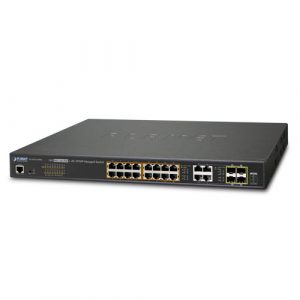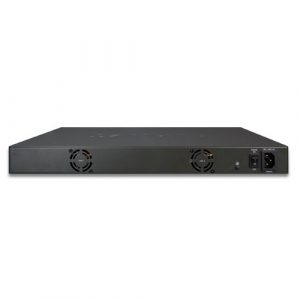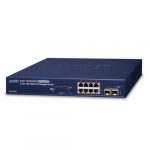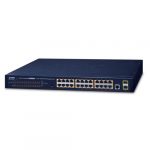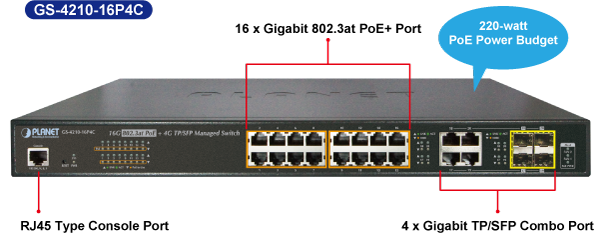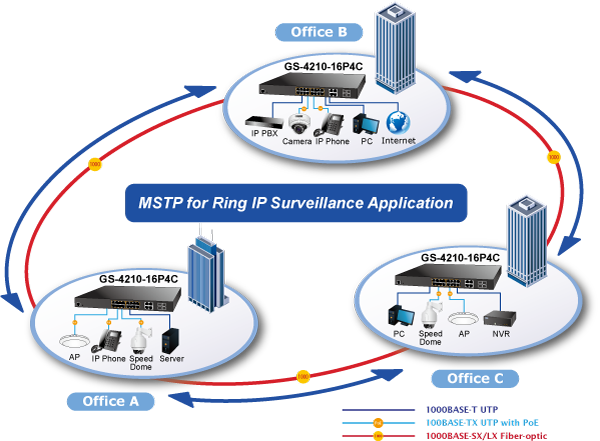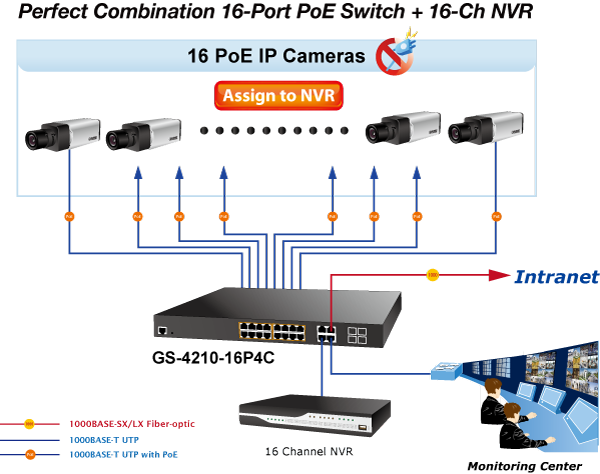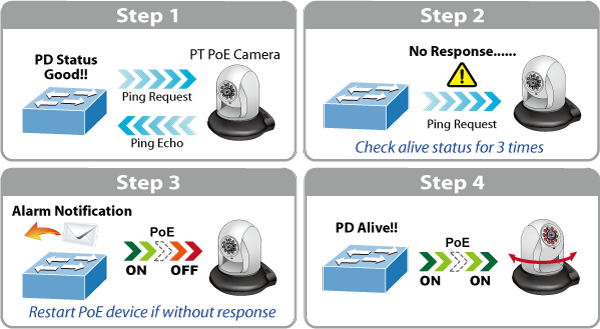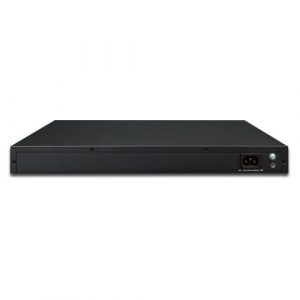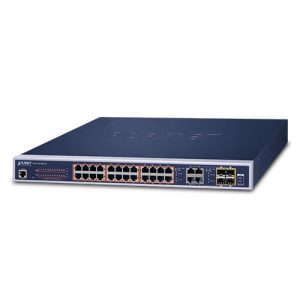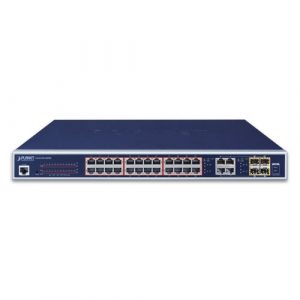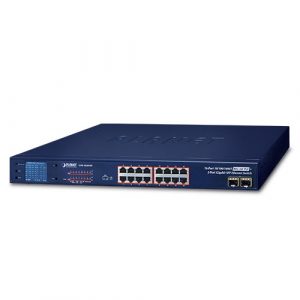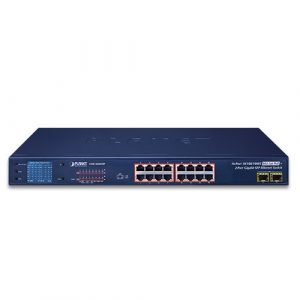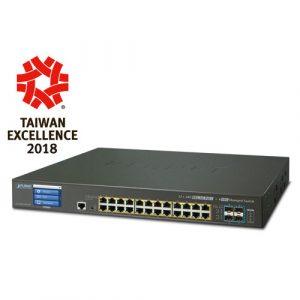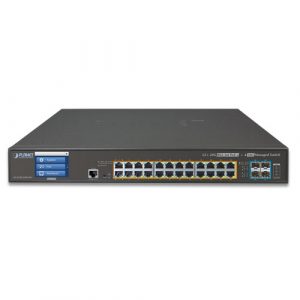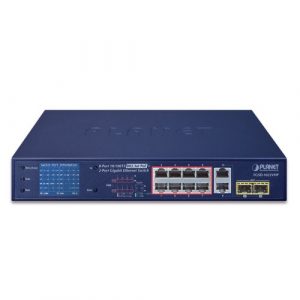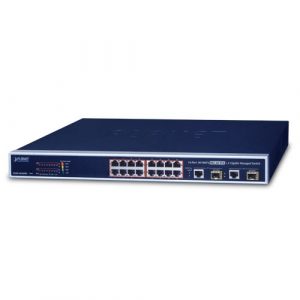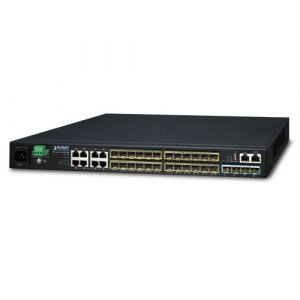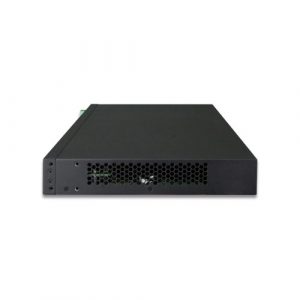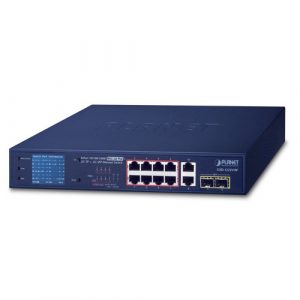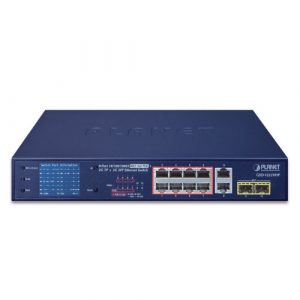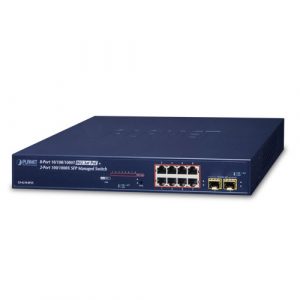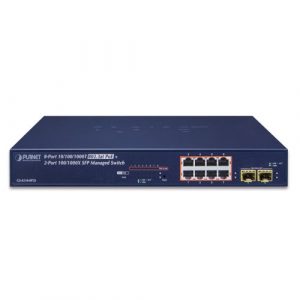GS-4210-16P4C
IPv6/IPv4, 16-Port 802.3at POE, Managed Gigabit Switch + 4-Port Gigabit Combo TP/SFP (220W)
- Applicazioni
- SPECIFICHE
- DOWNLOAD
Descrizione
Protocollo Multiple Spanning Tree con soluzione PoE IP Office per PMI/Gruppi di lavoro
GS-4210-16P4C fornisce una forte capacità di auto-recupero rapido per prevenire interruzioni del servizio e intrusioni esterne. Incorpora nella rete di automazione del cliente la tecnologia 802.1s MSTP (Multiple Spanning Tree Protocol), per potenziare l’affidabilità del sistema e il tempo di attività. Conforme allo standard PoE IEEE 802.3at, può connettersi direttamente con qualsiasi nodo finale IEEE 802.3at quali telecamere di rete PTZ (Pan, Tilt & Zoom) e telecamere speed dome. Con questo switch è possibile realizzare facilmente un sistema wireless AP/telecamera IP/ VoIP controllato centralmente, per PMI e workgroup in aziende con un’infrastruttura di rete ad alta disponibilità.
Alta scalabilità e migliore sicurezza per soluzioni di rete IP e di Cyber Security
GS-4210-16P4C dispone di design non bloccante e moduli SFP in fibra ottica, consentendo maggiore flessibilità dell’infrastruttura di rete e ad un costo inferiore. Dotato di sedici porte PoE 10/100/1000BASE-T e quattro porte combo TP/SFP Gigabit, lo switch permette di costruire, facilmente, una sicurezza di rete sul sistema di cyber security per le aziende. Ad esempio, può funzionare con il router e UTM per garantire una sicurezza completa per le aziende di oggi.
Controllo live del dispositivo alimentato (PD)
Lo switch può essere configurato per monitorare, in tempo reale, lo stato del PD collegato, tramite comando ping. Nel caso in cui il PD smetta di funzionare e di rispondere, lo switch riprenderà l’alimentazione della porta PoE e riporterà il PD in funzione, aumentando così l’affidabilità della rete e riducendo l’onere di gestione dell’amministratore.
Riavvio automatico programmato
GS-4210-16P4C consente il riavvio, ad un’ora specifica di ogni settimana, delle telecamere IP o degli Access Point wireless, riducendo così l’eventualità di un crash a causa di un sovraccarico del buffer.
| Hardware Specifications | |
|---|---|
| Copper Ports | 20 x 10/100/1000BASE-T RJ45 auto-MDI/MDI-X ports |
| SFP/mini-GBIC Slots | 4 x 100/1000BASE-X SFP interfaces shared with Port-17 to Port-20. Supports 100/1000Mbps dual mode and DDM |
| PoE Injector Port | 16 ports with 802.3at/af PoE injector function (Port-1 to Port-16) |
| Console | 1 x RS-232-to-RJ45 serial port (115200, 8, N, 1) |
| Switch Architecture | Store-and-Forward |
| Switch Fabric | 40Gbps/non-blocking |
| Switch Throughput@64Bytes | 29.76Mpps |
| Address Table | 8K entries |
| Shared Data Buffer | 4.1 megabits |
| Flow Control | IEEE 802.3x pause frame for full-duplex Back pressure for half-duplex |
| Jumbo Frame | 10K bytes |
| Reset Button | < 5 sec: System reboot > 5 sec: Factory default |
| LED | PWR, SYS, LNK/ACT, PoE-in-Use, 1000, FAN 1 Alert, FAN 2 Alert, PoE PWR Alert |
| Smart Fan | 2 |
| Dimensions (W x D x H) | 440 x 300 x 44.5 mm, 19-inch, 1U height |
| Weight | 4.132kg |
| Power Requirements | AC 100~240V, 50/60Hz, auto-sensing |
| ESD Protection | 6KV DC |
| Power Consumption/Dissipation | 251 watts (max.)/861.2 BTU |
| Enclosure | Metal |
| Power over Ethernet | |
| PoE Standard | IEEE 802.3af/802.3at PoE/PSE |
| PoE Power Supply Type | End-span |
| PoE Power Output | Per port 52V DC, 30.8 watts (max.) |
| Power Pin Assignment | 1/2(+), 3/6(-) |
| PoE Power Budget | 220 watts (max.) @ 25 degrees C 190 watts (max.) @ 50 degrees C |
| PoE Ability PD @ 9 watts | 16 units |
| PoE Ability PD @ 15.4 watts | 14 units |
| PoE Ability PD @ 30 watts | 7 units |
| Layer 2 Functions | |
| Port Mirroring | TX/RX/both Many-to-1 monitor |
| VLAN | 802.1Q tagged-based VLAN Up to 256 VLAN groups, out of 4094 VLAN IDs 802.1ad Q-in-Q tunneling Voice VLAN Protocol VLAN Private VLAN (protected port) GVRP |
| Link Aggregation | IEEE 802.3ad LACP and static trunk Supports 4 groups of 8-port trunk |
| Spanning Tree Protocol | STP/RSTP/MSTP |
| IGMP Snooping | IGMP (v2/v3) Snooping IGMP Querier Up to 256 multicast groups |
| MLD Snooping | MLD (v1/v2) Snooping, up to 256 multicast groups |
| Access Control List | IPv4/IPv6 IP-based ACL, MAC-based ACL |
| QoS | 8 mapping ID to 8 level priority queues – Port number – 802.1p priority – 802.1Q VLAN tag – DSCP field in IP packet Traffic classification based, strict priority and WRR |
| Security | IEEE 802.1X – Port-based authentication Built-in RADIUS client to cooperate with RADIUS server RADIUS/TACACS+ user access authentication IP-MAC port binding MAC filtering Static MAC address DHCP Snooping and DHCP Option82 STP BPDU guard, BPDU filtering and BPDU forwarding DoS attack prevention ARP inspection IP source guard |
| Management Functions | |
| Basic Management Interfaces | Web browser; telnet; SNMP v1, v2c Firmware upgrade by HTTP/TFTP protocol through Ethernet network Remote/local syslog System log LLDP protocol SNTP |
| Secure Management Interfaces | SSH, SSL, SNMP v3 |
| SNMP MIBs | RFC 1213 MIB-II RFC 1215 Generic Traps RFC 1493 Bridge MIB RFC 2674 Bridge MIB Extensions RFC 2737 Entity MIB (version 2) RFC 2819 RMON (1, 2, 3, 9) RFC 2863 Interface Group MIB RFC 3635 Ethernet-like MIB |
| Standards Conformance | |
| Regulatory Compliance | FCC Part 15 Class A, CE |
| Standards Compliance | IEEE 802.3 10BASE-T IEEE 802.3u 100BASE-TX/100BASE-FX IEEE 802.3z Gigabit SX/LX IEEE 802.3ab Gigabit 1000T IEEE 802.3x flow control and back pressure IEEE 802.3ad port trunk with LACP IEEE 802.1D Spanning Tree Protocol IEEE 802.1w Rapid Spanning Tree Protocol IEEE 802.1s Multiple Spanning Tree Protocol IEEE 802.1p Class of Service IEEE 802.1Q VLAN tagging IEEE 802.1x Port Authentication Network Control IEEE 802.1ab LLDP IEEE 802.3af Power over Ethernet IEEE 802.3at High Power over Ethernet RFC 768 UDP RFC 793 TFTP RFC 791 IP RFC 792 ICMP RFC 2068 HTTP RFC 1112 IGMP version 1 RFC 2236 IGMP version 2 RFC 3376 IGMP version 3 RFC 2710 MLD version 1 RFC 3810 MLD version 2 |
| Environment | |
| Operating | Temperature: 0 ~ 50 degrees C Relative Humidity: 5 ~ 95% (non-condensing) |
| Storage | Temperature: -20 ~ 70 degrees C Relative Humidity: 5 ~ 95% (non-condensing) |







